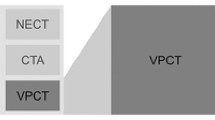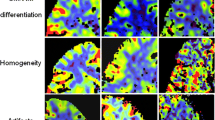Abstract
Objectives
To investigate whether iterative reconstruction (IR) in cerebral CT perfusion (CTP) allows for 50 % dose reduction while maintaining image quality (IQ).
Methods
A total of 48 CTP examinations were reconstructed into a standard dose (150 mAs) with filtered back projection (FBP) and half-dose (75 mAs) with two strengths of IR (middle and high). Objective IQ (quantitative perfusion values, contrast-to-noise ratio (CNR), penumbra, infarct area and penumbra/infarct (P/I) index) and subjective IQ (diagnostic IQ on a four-point Likert scale and overall IQ binomial) were compared among the reconstructions.
Results
Half-dose CTP with high IR level had, compared with standard dose with FBP, similar objective (grey matter cerebral blood volume (CBV) 4.4 versus 4.3 mL/100 g, CNR 1.59 versus 1.64 and P/I index 0.74 versus 0.73, respectively) and subjective diagnostic IQ (mean Likert scale 1.42 versus 1.49, respectively). The overall IQ in half-dose with high IR level was scored lower in 26–31 %. Half-dose with FBP and with the middle IR level were inferior to standard dose with FBP.
Conclusion
With the use of IR in CTP imaging it is possible to examine patients with a half dose without significantly altering the objective and diagnostic IQ. The standard dose with FBP is still preferable in terms of subjective overall IQ in about one quarter of patients.
Key points
• Computed tomography perfusion (CTP) is increasingly important in ischaemia imaging.
• Radiation exposure of CTP is a drawback.
• Iterative reconstruction (IR) allows reduction of radiation dose in unenhanced head CT.
• CTP IR enables 50 % dose reduction without altering objective and diagnostic quality.





Similar content being viewed by others
Abbreviations
- FBP:
-
filtered back projection
- HU:
-
Hounsfield units
- IR:
-
iterative reconstruction
- IQ:
-
image quality
References
Lin K, Do KG, Ong P et al (2009) Perfusion CT improves diagnostic accuracy for hyperacute ischemic stroke in the 3-hour window: study of 100 patients with diffusion MRI confirmation. Cerebrovasc Dis 28:72–79
Abels B, Klotz E, Tomandl BF, Villablanca JP, Kloska SP, Lell MM (2011) CT perfusion in acute ischemic stroke: a comparison of 2-second and 1-second temporal resolution. AJNR Am J Neuroradiol 32:1632–1639
Kloska SP, Fischer T, Sauerland C et al (2010) Increasing sampling interval in cerebral perfusion CT: limitation for the maximum slope model. Acad Radiol 17:61–66
Willemink MJ, de Jong PA, Leiner T et al (2013) Iterative reconstruction techniques for computed tomography Part 1: Technical principles. Eur Radiol 23:1623–1631
Primak AN, McCollough CH, Bruesewitz MR, Zhang J, Fletcher JG (2006) Relationship between noise, dose, and pitch in cardiac multi-detector row CT. Radiographics 26:1785–1794
Wintermark M, Flanders AE, Velthuis B et al (2006) Perfusion-CT assessment of infarct core and penumbra: receiver operating characteristic curve analysis in 130 patients suspected of acute hemispheric stroke. Stroke 37:979–985
Niesten JM, van der Schaaf IC, Riordan AJ, de Jong HW, Mali WP, Velthuis BK (2013) Optimisation of vascular input and output functions in CT-perfusion imaging using 256(or more)-slice multidetector CT. Eur Radiol 23:1242–1249
Pexman JH, Barber PA, Hill MD et al (2001) Use of the Alberta Stroke Program Early CT Score (ASPECTS) for assessing CT scans in patients with acute stroke. AJNR Am J Neuroradiol 22:1534–1542
Rapalino O, Kamalian S, Payabvash S et al (2012) Cranial CT with adaptive statistical iterative reconstruction: improved image quality with concomitant radiation dose reduction. AJNR Am J Neuroradiol 33:609–615
Landis JR, Koch GG (1977) The measurement of observer agreement for categorical data. Biometrics 33:159–174
Korn A, Fenchel M, Bender B et al (2012) Iterative reconstruction in head CT: image quality of routine and low-dose protocols in comparison with standard filtered back-projection. AJNR Am J Neuroradiol 33:218–224
Wintermark M, Smith WS, Ko NU, Quist M, Schnyder P, Dillon WP (2004) Dynamic perfusion CT: optimizing the temporal resolution and contrast volume for calculation of perfusion CT parameters in stroke patients. AJNR Am J Neuroradiol 25:720–729
Wintermark M, Maeder P, Verdun FR et al (2000) Using 80 kVp versus 120 kVp in perfusion CT measurement of regional cerebral blood flow. AJNR Am J Neuroradiol 21:1881–1884
Murase K, Nanjo T, Ii S et al (2005) Effect of x-ray tube current on the accuracy of cerebral perfusion parameters obtained by CT perfusion studies. Phys Med Biol 50:5019–5029
Kamena A, Streitparth F, Grieser C et al (2007) Dynamic perfusion CT: optimizing the temporal resolution for the calculation of perfusion CT parameters in stroke patients. Eur J Radiol 64:111–118
Wiesmann M, Berg S, Bohner G et al (2008) Dose reduction in dynamic perfusion CT of the brain: effects of the scan frequency on measurements of cerebral blood flow, cerebral blood volume, and mean transit time. Eur Radiol 18:2967–2974
Funama, Taguchi, Utsnuomiya et al (2012) Combination of a low-tube-voltage technique with hybrid iterative reconstruction (iDose) algorithm at coronary computed tomographic angiography. J Comput Assist Tomogr 35:480–485
Kilic K, Erbas G, Guryildirim M, Arac M, Ilgit E, Coskun B (2011) Lowering the dose in head CT using adaptive statistical iterative reconstruction. AJNR Am J Neuroradiol 32:1578–1582
Bulla S, Blanke P, Hassepass F et al (2012) Reducing the radiation dose for low-dose CT of the paranasal sinuses using iterative reconstruction: feasibility and image quality. Eur J Radiol 81:2246–2250
Vorona GA, Zuccoli G, Sutcavage T, Clayton BL, Ceschin RC, Panigrahy A (2013) The use of adaptive statistical iterative reconstruction in pediatric head CT: a feasibility study. AJNR Am J Neuroradiol 34:205–211
Ren Q, Dewan SK, Li M et al (2012) Comparison of adaptive statistical iterative and filtered back projection reconstruction techniques in brain CT. Eur J Radiol 81:2597–2601
Machida H, Takeuchi H, Tanaka I et al (2012) Improved delineation of arteries in the posterior fossa of the brain by model-based iterative reconstruction in volume-rendered 3D CT angiography. AJNR 34:971–975
Suzuki S, Machida H, Tanaka I, Ueno E (2013) Vascular diameter measurement in CT angiography: comparison of model-based iterative reconstruction and standard filtered back projection algorithms in vitro. AJR Am J Roentgenol 200:652–657
Ma J, Zhang H, Gao Y et al (2012) Iterative image reconstruction for cerebral perfusion CT using a pre-contrast scan induced edge-preserving prior. Phys Med Biol 21:7519–7542
Manhart MT, Kowarschik M, Fieselmann A et al (2013) Dynamic Iterative reconstruction for interventional 4-D C-arm CT perfusion imaging. IEEE Trans Med Imaging 32:1336–1348
Scibelli A (2011) iDose4 iterative reconstruction technique. Philips Healthcare Whitepaper. https://www.healthcare.philips.com/pwc_hc/main/shared/Assets/Documents/ct/idose_white_paper_452296267841.pdf. Accessed 1 Jan 2013
Noel PB, Fingerle AA, Renger B, Munzel D, Rummeny EJ, Dobritz M (2011) Initial performance characterization of a clinical noise-suppressing reconstruction algorithm for MDCT. AJR Am J Roentgenol 197:1404–1409
Niu YT, Mehta D, Zhang ZR et al (2012) Radiation dose reduction in temporal bone CT with iterative reconstruction technique. AJNR Am J Neuroradiol 33:1020–1026
Abels B, Villablanca JP, Tomandl BF, Uder M, Lell MM (2012) Acute stroke: a comparison of different CT perfusion algorithms and validation of ischaemic lesions by follow-up imaging. Eur Radiol 22:2559–2567
Acknowledgments
Dutch Heart Foundation (grant 2008T034), NutsOhra Foundation (grant 0903-012).
Author information
Authors and Affiliations
Corresponding author
Rights and permissions
About this article
Cite this article
Niesten, J.M., van der Schaaf, I.C., Riordan, A.J. et al. Radiation dose reduction in cerebral CT perfusion imaging using iterative reconstruction. Eur Radiol 24, 484–493 (2014). https://doi.org/10.1007/s00330-013-3042-4
Received:
Revised:
Accepted:
Published:
Issue Date:
DOI: https://doi.org/10.1007/s00330-013-3042-4




